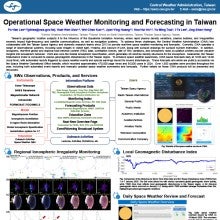Operational Space Weather Monitoring and Forecasting in Taiwan
Po-Han
Lee
Central Weather Administration, Taiwan
Poster
Taiwan’s geographic location subjects it to the influence of the Equatorial Ionization Anomaly, where rapid plasma density variations, plasma bubbles, and irregularities severely impact high-frequency and satellite communications, as well as navigation systems. To address these challenges, the Central Weather Administration (CWA) has collaborated with the Taiwan Space Agency and domestic research teams since 2013 to provide real-time space weather monitoring and forecasts. Currently, CWA operates a range of observational systems, including solar images in visible light, H-alpha, and Calcium K-Line, along with sunspot drawings for sunspot number estimation. In addition, ionograms, real-time global and regional total electron content (TEC) data, scintillation indices, rate of TEC variations, and ionospheric radio occultation profiles provide valuable insights into ionospheric behavior. CWA also runs the Global Ionospheric Specification, which generates 3D electron density structures for the ionosphere. Regarding geomagnetic field monitoring, CWA computes local geomagnetic disturbances, known as Taiwan Disturbance Index (TWDI), to estimate the local impact of space weather events. . To enhance space weather awareness, CWA issues forecasts twice daily, with automated reports triggered by space weather events and special warnings issued for severe disturbances. These forecasts and alerts are publicly accessible via the Space Weather Operational Office website, which recorded approximately 470 thousand page views and 55 thousand users in 2024. Over 1,600 updates were provided throughout the year, including both automated event reports and manually updated space weather summaries and forecasts. Further details on these CWA products will be presented and discussed.

Poster PDF
Poster category
Ionosphere and Thermosphere Research and Applications
Meeting homepage